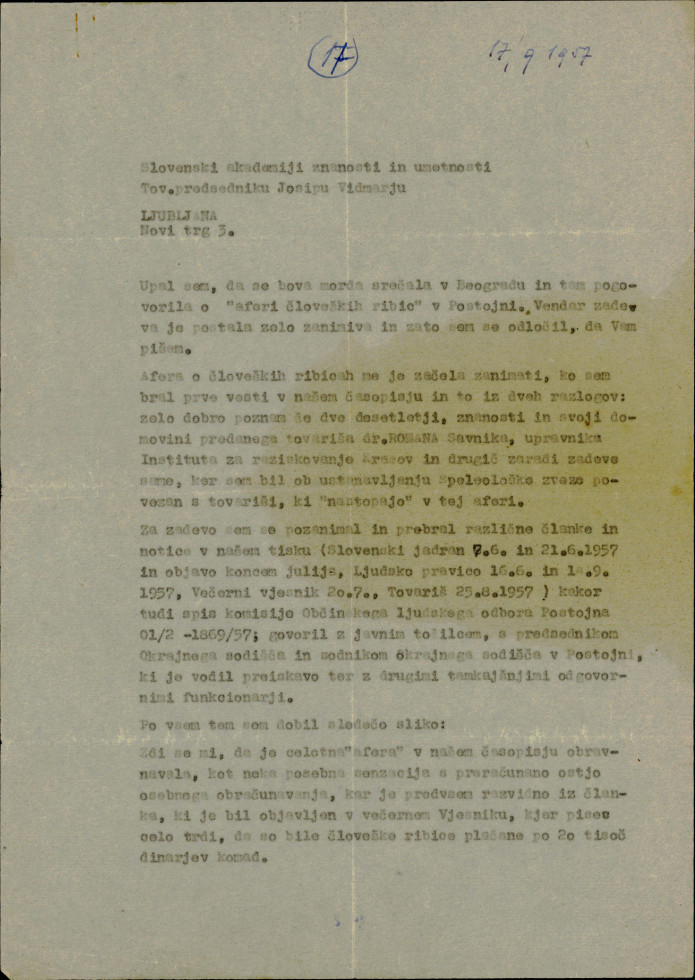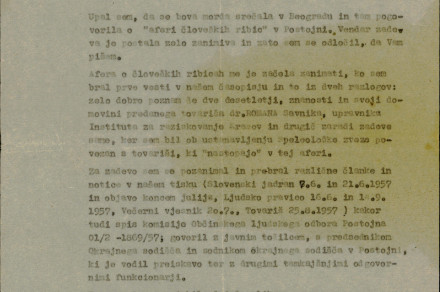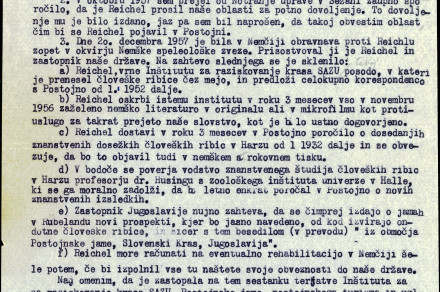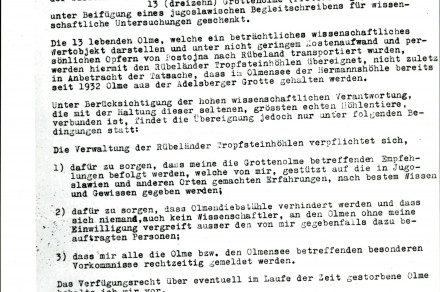The Olms from Postojna Cave in Germany: Stolen or Donated?
Murska Sobota, September 17, 1957
Original, 6 pages of typescript, prepared by Vanek Šiftar
Reference code: SI AS 1190, Savnik Roman, box 4, folder 1

A letter from V. Šiftar to the president of the Slovenian Academy of Sciences and Arts J. Vidmar, demanding to appoint a commission to investigate the involvement of the Karst Research Institute's personnel in the affair. | Author Arhiv Republike Slovenije
The olm, salamander or proteus (lat. Proteus anguinus) is a cave amphibian, which is endemic to the underground waters of the Dinaric Karst. Since this aquatic salamander is most frequently found here in Slovenia, it is rather surprising that as many as seven of them can currently also be seen in Hermann's Cave in the town of Rübeland, located in the German federal state of Saxony-Anhalt. Although today they are viewed as the cave's main attraction, they were actually introduced into Hermann's Cave artificially and were brought there from Postojna Cave. At the end of 1956, the removal of thirteen olms from Postojna Cave caused a major scandal that reverberated across the former Yugoslavia and the East and West Germany. Some archival records in connection to the story have been preserved by the Archives of the Republic of Slovenia among the private records of Dr. Roman Savnik (SI AS 1190), Slovenian geographer and karstologist, who in his capacity as the head of the Karst Research Institute at the Slovenian Academy of Sciences and Arts was directly involved in the story. The course of the events is partly described in a letter presented here as this month's archivalia, which was written by the federal representative Vanek Šiftar to the president of the Slovenian Academy of Sciences and Arts Josip Vidmar. Certain pieces of the story can also be detected in some of the other original records, document copies and newspaper clippings, collected by Dr. Roman Savnik and preserved in the same folder as the above-mentioned letter.
The ”export” of the olms to Rübeland has a pre-history which had an indirect effect on the events taking place in the late 1956. In 1932, the then manager of Postojna Cave Andrej Perko handed over ten of these Postojna Cave native salamanders to Dr. Walter Biese, a geologist from Berlin. Three of them were taken to the Segeberg Caves north of Hamburg, five to Hermann's Cave in Rübeland, and two did not survive the transportation. Those intended for Segeberg Caves died soon after their arrival due to the inappropriate habitat of their new home. In Hermann's Cave, however, a special pool (the so-called Olmensee) was prepared for the newcomers, in which the olms seemed to feel all right, judging from the fact that they were all alive and well in 1951. In 1952, however, two of them went missing which prompted an investigation ordered by the manager of the caves in Rübeland Fritz Brandes. The investigation revealed that the disappearance of the olms was due to the alleged geologist and karstologist Wolfgang Reichel conducting illegal experiments with the animals. Bandes banned him from accessing the lake with the olms and instructed his cave staff to keep a close eye on him.
That same year, Wolfgang Reichel, a native of Dresden and married to the daughter of the owner of the cave restaurant in Rübeland, where he also worked as a waiter, wrote a letter to the Postojna Cave management on behalf of the Geological Institute of the Mining Academy in Freiberg. In it, he asked for a few live specimens of the olm, which the institute supposedly needed for research purposes. The management of Postojna Cave forwarded his letter to the Karst Research Institute of the Slovenian Academy of Sciences and Arts. Having read the letter in which Reichel explained that they intended to release the donated animals into different habitats to live under different conditions, the head of the Karst Research Institute Dr. Roman Savnik broke off any further correspondence with Reichel. The latter, however, remained persistent in his pursuit and made contact with the Postojna branch of the Slovenian Cave Exploration Society and its president at the time France Habe. Reichel and Habe arranged a meeting in Postojna, where Reichel and his wife Ingeburg arrived on November 17, 1956. In Postojna, Reichel held a lecture, he and his wife visited Postojna Cave and some other caves and paid a visit to the Karst Research Institute. At the institute, Dr. Savnik informed Reichel that permits for any export of live specimens of olm for scientific purposes could only be granted by the Institute of Biology in Ljubljana. Reichel chose to completely ignore this information and on November 22, 1956, accompanied by his wife and France Habe, and carrying a can for transporting olms, which he supposedly got from an unknown institute’s employee, he went to see the manager of Postojna Cave Elo Garzarolli. Reichel showed him the letter written by Dr. Savnik in 1952, in which he wrote that Reichel could obtain live specimens of olms, but only for the purposes of scientific research. Garzarolli, who did not seem to pay much attention to the content of the letter or its date, ordered one of the cave guides to catch some olms for his German visitor. Thirteen live olms were taken from the cave pool and given to Reichel, who then caried them out of Postojna Cave. The next day Reichel and his wife visited Ljubljana (not the Institute of Biology though) and then on November 24, 1956 travelled to Venice via Sežana. Reichel sent his wife, who carried the can with the olms and the “export permission” signed by France Habe, home, while he extended his trip and did not return back to Rübeland until December 24, 1956. That same day he signed a deed of gift and donated thirteen olms from Postojna Cave to the management of the caves in Rübeland. The newly acquired olms were then placed into Hermann’s Cave.
The event could easily have escaped any notice, had the news of the unlawful removal of the olms not become public. Yugoslav newspapers put the blame for the scandal mostly on the Karst Research Institute, which drove the head of the institute Dr. Savnik to dedicate the following two years of his life to gathering and collecting documentation, which would restore his and the institute’s good name. He was helped in his efforts by the Association of German Cave and Karst Researchers from Münich, who launched an investigation against Wolfgang Reichel. At the meeting held on December 12, 1957 by the Association of German Cave and Karst Researchers, where Savnik and Reichel were present as well, it was decided that Reichel be banned from working with the olms in Hermann’s Cave, and also that the management of the caves in Rübeland had to state in their brochures that the specimens living in their caves actually originated from Postojna Cave. Today, the website of Rübland caves states that a couple from Rübland brought thirteen olms to Hermann’s Cave from »Postojane (Adelsberg/Slowenien)« in 1956 as part of their study trip.
Documentation gathered in Germany absolved the Slovenian Karst Research Institute and its personnel of any quilt related to the unlawful removal of the olms from Postojna Cave and the District Court in Koper even suspended criminal proceedings against France Habe due to lack of evidence. Despite this, Habe had to step down as the president of the Cave Research Society in Postojna and quit his job as a professor at the Postojna grammar school to start teaching at a local primary school in Rakek. No action was taken against the management of Postojna Cave.
Although the commission established that Dr. Savnik was not involved in this whole affair, he still had to suffer the consequences. As he revealed in 1985 when transferring his private records into the Archives of the Republic of Slovenia for safekeeping, he had to cut off all official contacts with his colleagues in foreign countries and was obstructed in his professional work at the institute until eventually the »hopelessness of the whole situation« forced him to retire in 1962. Wolfgang Reichel divorced his wife in a couple of years and moved from Rübland. No other news about him can be found. Ingeburg Reichel, her second married name Kopp, revealed her view on the infamous removal in her 2016 interview for the magazine Volksstimme, in which she categorically denied any rumours that she and her husband had stolen the olms from Postojna Cave.
Danijela Juričić Čargo
- Knolle, F., Puffe, B.: Wie kamen die Grottenolme in die Hermannshöhle?, in: Neue Wernigeröder Zeitung, vol. 27, no. 4, 24. 2. 2016, p. 9.
- Savnik, Roman: Habe, France (1909–1999). Slovenska biografija. Slovenska akademija znanosti in umetnosti, Znanstvenoraziskovalni center SAZU, 2013.
- Der Grottenolm im Olmensee der Hermannshöhle.
- Mehlhose, Ingmar: Grottenolme wurden nicht gestohlen.




